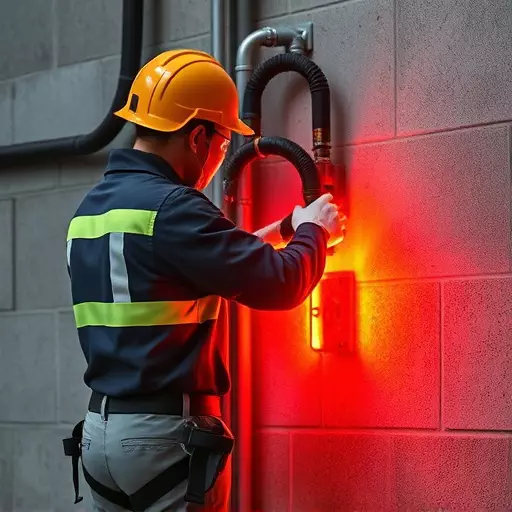The arc flash study process is a critical, data-driven approach to electrical hazard analysis, identifying and mitigating risks from arc flashes, electrocution, and other electrical events. It involves analyzing equipment, operations, and protective systems to determine energy release potential and select appropriate personal protective equipment (PPE). Based on this study, organizations develop customized arc flash safety plans including PPE guidelines, warning labels, and emergency protocols, ensuring compliance with standards like NFPA while prioritizing worker well-being in high-risk electrical environments. Regular updates are essential due to changing equipment or regulations, fostering a proactive culture of arc flash safety awareness.
Ensuring worker safety in electrical environments is paramount, as electrical hazards pose significant risks with potentially devastating consequences. This article guides you through critical aspects of worker protection, focusing on two essential components: the arc flash study process and implementing effective arc flash safety standards. We’ll also explore key elements of a successful electrical hazard analysis to help organizations mitigate risks effectively. By understanding and navigating these areas, businesses can foster safer work environments and avoid costly incidents.
- Understanding Electrical Hazards and Their Impact on Workers
- The Arc Flash Study Process: A Comprehensive Guide
- Implementing Effective Arc Flash Safety Standards
- Key Components of a Successful Electrical Hazard Analysis
Understanding Electrical Hazards and Their Impact on Workers

Electrical environments present unique and often hidden dangers that can have severe consequences for workers. Understanding electrical hazards is a crucial step in ensuring worker safety. These hazards include electric arcs, which can release intense heat and light, causing serious burns and even fatalities. An arc flash study process involves meticulous analysis of equipment, operation scenarios, and protective systems to predict the potential impact of such events. This data-driven approach informs the development of arc flash safety standards, which guide the selection of appropriate personal protective equipment (PPE) and system design.
A comprehensive electrical hazard analysis is not just a regulatory requirement but a proactive measure to foster a safer work environment. It involves identifying risks associated with high-voltage systems, ground faults, overloads, and more. By systematically evaluating these hazards, organizations can implement targeted mitigation strategies. This may include upgrading aging infrastructure, installing advanced safety mechanisms, providing specialized training, and promoting a culture of awareness and adherence to arc flash safety standards.
The Arc Flash Study Process: A Comprehensive Guide

The Arc Flash Study Process is a critical component of ensuring worker safety in electrical environments. It involves a comprehensive electrical hazard analysis that identifies potential risks associated with arc flash events. This process begins with a thorough evaluation of existing electrical systems, equipment, and work practices to determine the likelihood and severity of an arc flash incident. By employing specialized software and following arc flash safety standards, organizations can accurately calculate energy release and identify appropriate personal protective equipment (PPE) requirements.
This detailed analysis extends to the study of system grounding, overcurrent protection devices, and fault clearance times. It also considers human factors, such as training and work procedures, to mitigate risks effectively. The outcome is a tailored arc flash safety plan that includes recommended PPE, warning labels, and emergency response protocols, ensuring compliance with relevant electrical hazard analysis standards while prioritizing the well-being of workers in high-risk electrical environments.
Implementing Effective Arc Flash Safety Standards

Implementing effective arc flash safety standards is a critical step in protecting workers from the severe risks associated with electrical environments. The process begins with a thorough arc flash study, which involves a detailed analysis of the electrical system to identify potential hazards. This includes evaluating equipment, circuits, and components for vulnerabilities that could lead to an arc flash event. By understanding these risks, employers can develop comprehensive safety protocols tailored to their specific operations.
Following the arc flash study process, organizations should establish and enforce arc flash safety standards aligned with industry best practices and regulatory requirements. These standards should encompass personal protective equipment (PPE) guidelines, proper training for workers, and regular maintenance of electrical systems to minimize hazards. A proactive approach to electrical hazard analysis ensures that safety measures are in place before an incident occurs, fostering a safer work environment for everyone involved.
Key Components of a Successful Electrical Hazard Analysis

A successful electrical hazard analysis is a comprehensive process that considers various factors to ensure worker safety in high-risk environments. The first step involves identifying all potential electrical hazards, including but not limited to arc flash and electrocution risks. This requires a thorough review of existing systems, operations, and relevant arc flash study data. By mapping out the workplace layout, equipment, and power distribution, experts can pinpoint areas requiring special attention.
The analysis should adhere to established arc flash safety standards, such as those provided by the National Fire Protection Association (NFPA). These standards offer guidelines for risk assessment, protective clothing, and engineering controls. Integrating this data with regular maintenance practices ensures that any issues are addressed promptly, minimizing potential hazards. Regular updates to the analysis are crucial due to changes in equipment, work procedures, or regulatory requirements.


